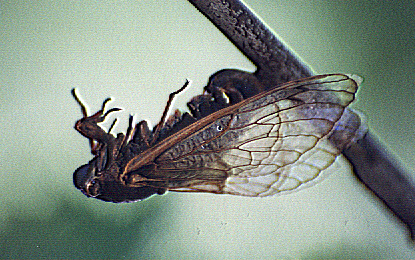Great Lakes Cicada Page | home
Introducing the Cicada | Life Cycle | 1999 Brood V Account | My Journeys | Magicicada Galleries | Magicicada Gallery 2 | Magicicada Nymphs | Chimneys & Emergence Holes | Magicicada Emergence | Magicicada Emergence 2 | Magicicadas Feeding | Magicicada Mating | Magicicada Ovipositing | Eggs & Egg Damage | Cicada Mortality | Brood Maps | Tibicen Galleries | Tibicen Gallery 2 | Tibicen Nymphs | Tibicen Emergence | Tibicen Emergence 2 | Tibicen Feeding & Ovipositing | Okanagana Galleries | Field Guide | How to Find | Deterrence | Armed Robbery??? | My Story | About Me | Cicada Links | The Future
Cicada Mortality

The victim of the fungus (Massosporan). This species of fungus attacks only the Genus Magicicada. The spores of this fungus remain dormant on the ground for 13 or 17 years until the cicada population emerges. The newly emerged nymphs become infected and begin their normal adult lives. The fungus grows within the cicada's body until the insect's abdomen breaks completely off and releases a new generation of spores. Since the cicada goes about life normally and unaware of its parasite, it will mingle with other cicadas and mate with them, thus spreading the fungus throughout the cicada colony.
Eventually, the fungus will kill the cicada but not before it can effect others.
Photo taken: 06/99 - Findley State Park, Lorain County, Ohio

A victim of an attack. Here is a Magicicada that was partially eaten but still survived. However, this Magicicada was weak despite still being able to move and climb a tree trunk. This cicada probably died within the day.
Many cicadas are eaten by birds, their primary enemies. The cicadas have many other enemies which include spiders, squirrels, rodents, domestic animals, and man.
Photo taken: 06/99
Findley State Park
Lorain County, Ohio

A crippled adult Magicicada whose wings failed to expand properly due to overcrowded conditions at the time of its emergence. During large emergences, this is very common... Many of these cicadas die within the first couple of days and many are found on or near the ground. Some, despite their condition, go about and lead productive lives.
Photo taken: 05/99
Findley State Park
Lorain County, Ohio

This Magicicada became trapped in its exuviae during its emergence. Its body had already hardened and its wings had partially expanded. This cicada eventually died.
Photo taken: 05/99
Findley State Park
Lorain County, Ohio

A few more cicadas that failed to emerge from their husks successfully.
When overcrowded, the cicadas will emerge from their exuviae while clinging to other cicadas attempting to do the same thing. The less fortunate thus become trapped or crippled.
Photo taken: 05/99
Findley State Park
Lorain County, Ohio

A close up of the less fortunate. Here is a cicada attempting to shed its skin on top of another cicada doing the same thing. Both soon died as a result of their overcrowded conditions.
Photo taken: 05/99
Findley State Park
Lorain County, Ohio

A trapped adult on the side of a tree trunk. These cicadas are easy prey and often fall victim to predator attacks or bake to death in the hot sun.
However, if these adults manage to survive into the night, they are often knocked free of their perch when the next evening's round of cicadas emerge from the ground. This new round of cicadas begin to ascend the tree trunk in search of available space to shed their own skins.
Photo taken: 05/99
Findley State Park
Lorain County, Ohio

Another cicada that has failed to emerge properly and will soon die.
Photo taken: 05/99
Findley State Park
Lorain County, Ohio

The adult life of the Magicicada usually last between two and six weeks. Normally not more than three. Just enough time to sing, mate, and lay their eggs in preparation for the next generation.
Here is a pile of Magicicada cassini and M. decula at the base of a tree.
Photo taken: 06/99
Findley State Park
Lorain County, Ohio

A female Magicicada that died upon completion of her egg nests. This one died with its ovipositor still lodged in its last nest.
Photo taken: 06/99
Findley State Park
Lorain County, Ohio

The end result....
Near the end of the Magicicada emergence, they will begin to fall from the trees by the thousands. Their bodies will pile up at the base of the trees. The smell of decay will become very repugnant once the corpses begin to bake in the hit summer sum.
Photo taken: 06/98
(Brood XIX)
Robert Allerton Park
Piatt County, Illinois